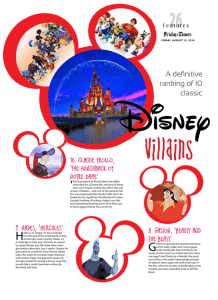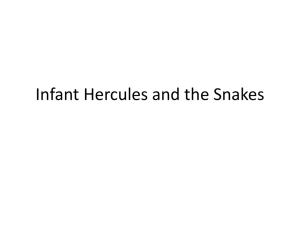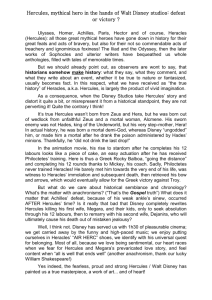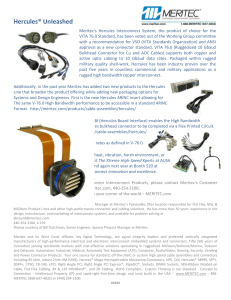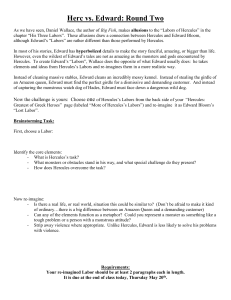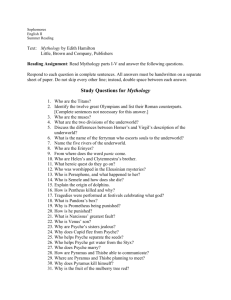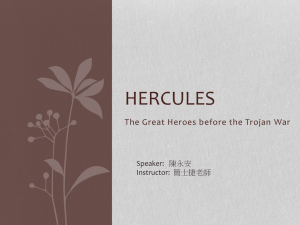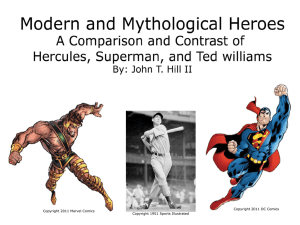The Twelve Labors of Hercules brochure
advertisement
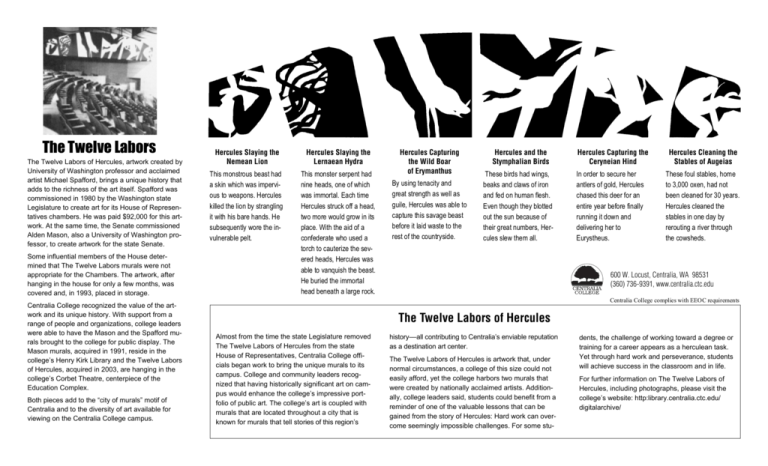
The Twelve Labors The Twelve Labors of Hercules, artwork created by University of Washington professor and acclaimed artist Michael Spafford, brings a unique history that adds to the richness of the art itself. Spafford was commissioned in 1980 by the Washington state Legislature to create art for its House of Representatives chambers. He was paid $92,000 for this artwork. At the same time, the Senate commissioned Alden Mason, also a University of Washington professor, to create artwork for the state Senate. Some influential members of the House determined that The Twelve Labors murals were not appropriate for the Chambers. The artwork, after hanging in the house for only a few months, was covered and, in 1993, placed in storage. Centralia College recognized the value of the artwork and its unique history. With support from a range of people and organizations, college leaders were able to have the Mason and the Spafford murals brought to the college for public display. The Mason murals, acquired in 1991, reside in the college’s Henry Kirk Library and the Twelve Labors of Hercules, acquired in 2003, are hanging in the college’s Corbet Theatre, centerpiece of the Education Complex. Both pieces add to the “city of murals” motif of Centralia and to the diversity of art available for viewing on the Centralia College campus. Hercules Slaying the Nemean Lion Hercules Slaying the Lernaean Hydra This monstrous beast had a skin which was impervious to weapons. Hercules killed the lion by strangling it with his bare hands. He subsequently wore the invulnerable pelt. This monster serpent had nine heads, one of which was immortal. Each time Hercules struck off a head, two more would grow in its place. With the aid of a confederate who used a torch to cauterize the severed heads, Hercules was able to vanquish the beast. He buried the immortal head beneath a large rock. Hercules Capturing the Wild Boar of Erymanthus By using tenacity and great strength as well as guile, Hercules was able to capture this savage beast before it laid waste to the rest of the countryside. Hercules and the Stymphalian Birds These birds had wings, beaks and claws of iron and fed on human flesh. Even though they blotted out the sun because of their great numbers, Hercules slew them all. Hercules Capturing the Ceryneian Hind In order to secure her antlers of gold, Hercules chased this deer for an entire year before finally running it down and delivering her to Eurystheus. Hercules Cleaning the Stables of Augeias These foul stables, home to 3,000 oxen, had not been cleaned for 30 years. Hercules cleaned the stables in one day by rerouting a river through the cowsheds. 600 W. Locust, Centralia, WA 98531 (360) 736-9391, www.centralia.ctc.edu Centralia College complies with EEOC requirements The Twelve Labors of Hercules Almost from the time the state Legislature removed The Twelve Labors of Hercules from the state House of Representatives, Centralia College officials began work to bring the unique murals to its campus. College and community leaders recognized that having historically significant art on campus would enhance the college’s impressive portfolio of public art. The college’s art is coupled with murals that are located throughout a city that is known for murals that tell stories of this region’s history––all contributing to Centralia’s enviable reputation as a destination art center. The Twelve Labors of Hercules is artwork that, under normal circumstances, a college of this size could not easily afford, yet the college harbors two murals that were created by nationally acclaimed artists. Additionally, college leaders said, students could benefit from a reminder of one of the valuable lessons that can be gained from the story of Hercules: Hard work can overcome seemingly impossible challenges. For some stu- dents, the challenge of working toward a degree or training for a career appears as a herculean task. Yet through hard work and perseverance, students will achieve success in the classroom and in life. For further information on The Twelve Labors of Hercules, including photographs, please visit the college’s website: http:library.centralia.ctc.edu/ digitalarchive/ CENTRALIA COLLEGE PRESENTS Hercules Subduing the Mad Bull of Crete Hercules Capturing the Mares of Diomedes Hercules had to subdue and transport this ferocious crazed beast across the sea to Eurystheus. These flesh-eating monsters were extremely difficult to capture. By positioning himself just right, Hercules was able to avoid being devoured. He subdued the horses and delivered them to Eurystheus. Hercules and Hippolyte Hercules and Antaeus Hercules was sent to fetch the magnificent jeweled girdle from this Amazon Queen and it was given him willingly. However, a false rumor that their queen was being kidnapped made the Amazon people attack Hercules. Believing that he’d been betrayed, he slaughtered the Amazons and their queen. Antaeus was a monstrous bandit who forced all he met to wrestle with him to the death. He was the son of Gaea, Mother Earth, and had the power of regaining his strength simply by touching the ground. After many hours of wrestling, Hercules vanquished the monster by placing the crushed body in a tree. Hercules Capturing Cerberus Hercules Wrestling with Death Hercules ventured into the Underworld to overpower Cerberus, the three-headed hound of Hell. After gaining permission to bring him to the earth’s surface, he carried the struggling beast to Eurystheus to verify the deed. Hercules had previously wrestled with death while rescuing Alcestis and emerged victorious from the struggle. As with all living things, however, the battle with death is finally a struggle which overwhelms us all. Twelve Labors of Hercules The mythological Hercules was the son of Alcmene, daughter of Electryon, and Jupiter. Juno, always hostile to the offspring of her husband by mortal mothers, sought ways to destroy the infant. The unique strength of Hercules became apparent when, while still in his cradle, he strangled two serpents sent by Juno to destroy him. Hercules became the national hero of Greece. But Hercules was not without his en- emies. One of them, Juno, drove Hercules insane. In his madness, Hercules slew his children and would have slain his wife, Amphitryon, but the gods intervened to prevent this. To atone for these killings, he was compelled to perform 12 impossible labors. Michael Spafford took artistic license in creating his murals. Panels 10 and 12 are myths associated with Hercules but are not among the original 12 labors. Charles Mills Galey, a University of California professor and an expert on mythology, notes in his book, The Classic Myths, that Hercules was originally tasked to capture the oxen of Geryon, a monster with three bodies, who dwelt in the island Erythea. Another of his tasks not included in the Spafford murals, is the robbery of the golden apples of the Hesperides. In place of these labors, Spafford chose to include the Hercules and Antaeus and Wrestling with Death panels. THE TWELVE LABORS OF HERCULES
